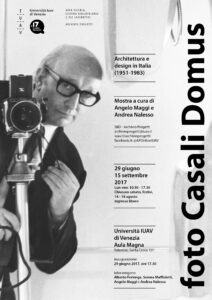 EXHIBITION: foto Casali Domus, architecture and design in Italy 1951-1983. Venice, 29 June – 15 September 2017
EXHIBITION: foto Casali Domus, architecture and design in Italy 1951-1983. Venice, 29 June – 15 September 2017
Università Iuav di Venezia, Tolentini, Aula Magna, Santa Croce 191, Venezia
monday > friday 10.30 > 17.30, free entrance
exhibition curated by Angelo Maggi e Andrea Nalesso
For over thirty years, Giorgio Casali (1913-1995) photographed the work of the greatest post-war Italian architects and designers. Although not a household name, Casali’s reputation as one of the most influential twentieth-century Italian photographers is assured through the striking imagery he produced for the monthly magazine Domus – Italy’s famous style bible. This summer exhibition at the University IUAV in Venice presents a selection of works from the vast collection of Casali’s images belonging to the Archivio Progetti, housed at IUAV University (EAHN Institutional Member). With their incredible subtlety and sophistication, these masterful images reveal why Casali’s vision came to be so valued by important figures such as Gio Ponti and Ettore Sottsass Jr.
Born in Lodi (Lombardy), Casali moved to Milan in 1928 where he worked as an apprentice in the Rambaldi photographic studio prior to establishing his own studio in partnership with Giovanni Muzzarelli. His career was to take a giant step forward in the early 1950s as a result of the images he took of Gio Ponti’s iconic Superleggera chair for Domus. Casali’s compositions effectively conveyed the design’s key feature – extreme lightness – through the use of models holding the object by a single finger. These images bore the hallmarks that were consistently to mark his work over the following three decades, being defined by their economy, wit, great elegance and commitment to presenting the object or building in question to its best advantage.Domus was founded by Ponti himself in 1928, and quickly became an incredibly influential magazine, going on to play a key role in the international dissemination of the Made in Italy ‘brand’, which asserted a quintessentially Italian sense of style through the creative reinvention and reinterpretation of everyday objects. Casali forged a collaborative relationship with Ponti that proved to be incredibly fruitful and which lasted until the early 1980s, hiswork charting post-war Italy’s growing self-confidence and position as a world leader in the spheres of architecture and design.
The images on display in fact span forty years of creativity in both of these fields, and will be divided into four sections, three of which will examine different aspects of Casali’s work for Domus. The first presents a selection of the thirty stylish cover images he created during his time working for the magazine, while the second and third explore his photographic treatment of key design objects and buildings of the period. These range from Ponti’s elegant Torre Pirelli (Milan, 1956) and extraordinary Cathedral for the southern Italian city of Taranto (1971), to Studio BBPR’s unmistakable Torre Velasca (Milan, 1958) and Roberto Monsani’s Villa Brody (Greve in Chianti, 1973) with its jutting, angular forms. Photographs of two celebrated lamps designed by Achille and Pier Giacomo Castiglioni – Arco (1962) and Ipotenusa (1975) – also feature. Due to their iconic status, many of these design classics remain in production and examples of these will also be on display in the exhibition spaces, including Ponti’s Superleggera chair and a mushroom-shaped, blown-glass lamp by Angelo Mangiarotti dating from 1966.
Casali’s work bore witness to the extraordinary explosion of creativity and innovation in Italian culture after World War Two, making this exhibition of interest not only to scholars of Italian art, architecture and design, but also to a public that recognises the exemplary value of the photographic image in chronicling the historical evolution of design.
